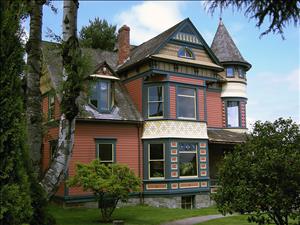Real Estate developer George S. List built a 13-room Victorian residence in the Madrona neighborhood with a view of Lake Washington and the Cascades. The main entrance was constructed to face the lake, away from the street. Visitors walked through a wrought-iron gate around to the front of the house. The design was by Thomas G. Bird. When it was built, 36th Avenue was called Lincoln Avenue and later Aldine Street.
In 1900, Charles Bussell (1864-1938) and his wife E.V. "Nina" Bussell (d. 1924) purchased the house. Bussell was a Seattle businessman (Seattle Soap Co.) who acquired large tracts of tideflats – wetlands that were under water at high tide. His investment was regarded as folly by some until 1906 when he sold much of the property to railroads for $1.5 million. Bussell lived in "the castle" (Kreisman) until 1928.
The home featured landscaped lawns, scalloped shingle siding, a circular tower, and woodwork of scrolled brackets. The interior was equally well appointed with paneling, wainscoting, stained and leaded glass, and tiled fireplaces. In 1928, the new owners were inspired by the Mediterranean look of Rudolph Valentino films and opted for a Spanish hacienda look. They faced the exterior with stucco, but did not change the interior. In 1979, the Seattle City Council named the house a Seattle Landmark because of its distinctive architectural style and its association with an important Seattle resident. In 1994, new owners removed the stucco for a return to the wooden exterior. Address: 1630 36th Avenue, Seattle.

